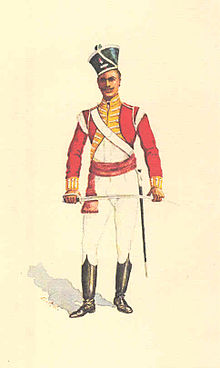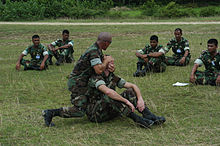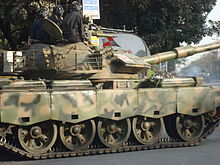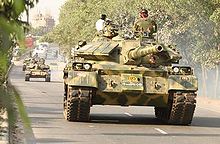- Bangladesh Army
-
Bangladesh Army 
Active 26 March 1971 – present Country  Bangladesh
BangladeshAllegiance Bangladesh Branch Army Type Land Warfare Size 280,000 (approx)[1] Part of Bangladesh Armed Forces Army Headquarter Dhaka Cantonment Nickname BA Patron President of Bangladesh Anniversaries 26 March
10 April
21 November
16 DecemberEngagements Bangladesh Liberation War
Chittagong Hill Tracts InsurgencyDecorations 1. Bir Sreshtho
2. Bir Uttom
3. Bir Bikrom
4. Bir ProtikWebsite www.army.mil.bd Commanders COAS General Md Abdul Mubeen, ndc, psc QMG Lieutenant General Iqbal Karim Bhuiyan CGS Lieutenant General Moinul Islam Notable
commandersGeneral M A G Osmani
Major General K M Shafiullah
Lieutenant General Ziaur Rahman
Brigadier General Khaled Mosharraf
Colonel Shafaat JamilThe Bangladesh Army (Bangla: বাংলাদেশ সেনা বাহিনী) is the land forces branch and the largest of the three uniformed service of the Bangladesh Armed Forces. The primary mission of the Army is to provide necessary forces and capabilities in support of Bangladesh's security and defense strategies including defense of the nation's territorial integrity against external attack. Control and operations are administered by the Department of the Army of the Armed Forces Division. The civilian head is the Prime Minister, who by law also holds the defense ministry portfolio. In addition to its primary mission the Bangladesh Army is also constitutionally obligated to assist the civilian government during times of national emergency. This role is commonly referred to as “aid to civil administration”.
Contents
History
Early history
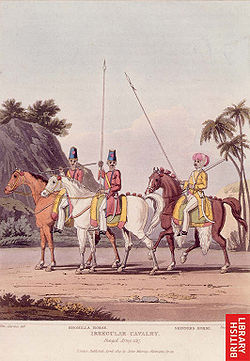 A painting of Irregular cavalry of the Bengal Army, 1817.
A painting of Irregular cavalry of the Bengal Army, 1817.
The martial tradition of Bengal has its roots in the Bengal Army during Mughal rule since the early 18th century, when three successive Persian Muslim dynasties, namely the Nasiri, Afshar and Najafi, ruled Bengal.[citation needed] During the Colonial Rule of the British, Bengal was principally a bulwark of British power and trade in the South Asian region. The British under Robert Clive defeated a 50,000 strong Bengal Army of Nawab Siraj-ud-daullah in the Polashey(Plassey) in 1757 and later the forces of Nawab Mir Qasim at the Battle of Buxar in 1764. The Army of Bengal was formed, which later became part of a united Indian Army from 1895 to 1947. The eastern part of the region was a prominent place for military and police recruitment, with entire horse-mounted cavalry and lancer units being recruited there prior to the Bengal Sepoy Mutiny of 1857.[citation needed] Post-mutiny, units with the epithet "Bengal" in their name, such as Bengal Sappers and Bengal Cavalry, were largely recruited from non-Bengali peoples from Bihar, Varanasi and Uttar Pradesh which were technically still part of Bengal Presidency at that time. After the creation of the nation of Pakistan, recruitment from erstwhile East Pakistan began in 1948 into the East Bengal Regiment, newly created with all Bengali personnel, part of the Pakistan Army till 1971.[citation needed]
Formation during Bangladesh Liberation War 1971
Military operations were formally launched after the Sector Commanders Conference during 11–17 July 1971. The conference was held three months after the oath of the newly formed Bangladesh Government at Meherpur, Kushtia. During this conference the structure and formation as well as resolving issues surrounding the organization of the various sectors, strategy and reinforcements of the Bangladeshi forces was determined. It was of considerable historical importance from a tactical point of view, as it determined the command structure of the Bangladeshi forces throughout Bangladesh Liberation War that was fought between Bangladesh(East Pakistan until 25 March 1971) and West Pakistan in 1971.
This conference was presided over by the Bangladesh interim government in exile, headed by then Prime Minister Tajuddin Ahmed and Colonel (Retd.) M A G Osmani. M A G Osmani was reinstated into active duty and promoted to General as the Commander-in-Chief of the Bangladesh Forces. Principal participants of this conference included: Wing Commander Khademul Bashar, Squadron Leader M.Hamidullah Khan, Major Ziaur Rahman, Major Abdul Jalil, Captain ATM Haider, Lt. Col. Abdur Rab and Group Captain A. K. Khandker. Lt.Col Rab was appointed as Chief of Army Staff. As a result of this meeting, Bangladesh was divided into eleven sectors.[citation needed] These sectors were placed under the control of Sector Commanders, who would direct the guerilla war against Pakistani occupation forces. For better efficiency in military operations each of the sectors were also divided into a number of sub-sectors. As a point of note, the 10th Sector was under direct command of the Commander-in-Chief and included the Naval Commando Unit as a C-in-C’s special force.
Following the conference a period of prolonged guerilla warfare was launched by Bangladesh Forces, which continued for a number of months. A further restructuring was undertaken, and the Bangladesh Forces were organized into three brigade size combat groups.
- K Force, under Major Khaled Mosharraf, was created with 4th, 9th and 10th East Bengal Regiment.
- S Force, under Major K M Shafiullah, was created with 2nd and 11th East Bengal Regiment.
- Z Force, under Major Ziaur Rahman, was created with 1st, 3rd and 8th East Bengal Regiment.
On 3 December 1971, (West) Pakistan launched a futile and poorly planned pre-emptive attack on the western border of India, which marked the official entry of India into Bangladesh's liberation war. Finally, on 16 December 1971, after the Pakistan Armed Forces surrendered en masse to Indian Forces, the independent nation of Bangladesh emerged.
Post 1971: The emergence of the Bangladesh Army
Bangladesh Army has expanded considerably albeit erratically since its formation on 21 November 1971. During the sensitive and formative years after the end of the war, personnel of the Mukti Bahini were absorbed into different branches of Bangladesh Army. Sheikh Mujib's Awami League government created disenchantment among army personnel when his party formed and operated state funded separate militia groups around the nation run locally by his party men at the command of his son Sheikh Kamal. These policies and actions laid the foundation and formed the bedrock of disputes between professional army officers and the ruling administration.
Coups, uprisings and assassinations
The year 1975 was a turning point year in the history of Bangladesh as a nation. On 15 August 1975 few disgruntled members of the Bangladesh Armed Forces have been involved in two assassinations and coups albeit without the knowledge or participation of the entire Bangladesh Armed Forces. In 1975 a few sacked, disgruntled junior officers and NCOs secretly planned and assassinated the entire immediate family of Sheikh Mujibur Rahman at his personal residence in Dhanmondi, Dhaka, with the exception of his two daughters who were abroad. Some of those responsible officers were finally brought to justice in January 2010. Some are still at large. A new government led by Khandkar Mushtaq Ahmed and almost the entire cabinet of Sheikh Mujib's government was set in place. Three months later on 3 November 1975, several senior officers and NCO's led by Brig. Gen. Khaled Musharraf and Colonel Shafaat Jamil led their own forces to untangle another internal conspiracy and removed Khandakar Mushtaq's government from power whom they believed was an unlawful government in the first place. That same day the same group of disgruntled army personnel who assassinated Sheikh Mujib and his family took action that resulted in the assassination and jailing of several senior Army officers and noted civilians who were involved in the nations war of independence. Those jailed and later assassinated inside the jail premises were Syed Nazrul Islam, Tajuddin Ahmed, Muhammad Mansur Ali and AHM Qamaruzzaman. Chief of Army Staff, Major General Ziaur Rahman was placed under house arrest. On 7 November 1975, a short but highly organized uprising concentrated only in Dhaka, formed by members of the Jatiya Samajtantric Dal (National Socialist Party) and members of lower-ranking army personnel led by Lt. Col.(Retd.) Abu Taher also resulted in the killing of several army and air force officers and men including Brigadier General Khaled Musharraf, Major ATM Haider to name just a few. Colonel Shafaat Jamil was arrested and forcibly retired. Major General Ziaur Rahman was released and took the opportunity to bring order and discipline in the country as well as in the armed forces under temporary martial law. Zia took promotion to Lieutenant General and was appointed Chief of Army Staff and Deputy Chief Martial Law Administrator. Later, in 1977 under a public referendum of a yes no vote he took the helm as President. On 30 May 1981 President Ziaur Rahman was assassinated in the Chittagong Circuit House in a military coup. Less than a year later, the then Chief of Army Staff Lt. Gen. Hussein Muhammad Ershad in 1981 March 24 took power in a silent coup at dawn, suspended the constitution and imposed martial law. He remained in power until 6 December 1990.
Subsequent growth
Following the 1975 coup, additional personnel were absorbed into the regular army when the martial law government abolished the Jatiyo Rakkhi Bahini. Under Zia's rule, Bangladesh was divided into five military regions. When Ershad assumed power in 1982, army strength had stabilized at about 70,000 troops. Starting in 1985, the army had experienced another spurt in growth. As of mid-1988, it had about 90,000 troops (although some observers believed the number was closer to 80,000), triple the 1975 figure.[2]
The Bangladesh Army structure is similar to the armies of the Commonwealth Nations. However, major changes have taken place following the adoption of U.S. Army tactical planning procedures, training management techniques and noncommissioned officer educational systems. In times of war and national emergency, the Bangladesh Army can also be reinforced by the Border Guard Bangladesh, Bangladesh Ansars, Village Defence Parties and other paramilitary organizations.
Bangladesh Army has specialized its peacekeeping operation capabilities around the world through participation in numerous peacekeeping and nation building operations. It has created BIPSOT (Bangladesh Institute of Peace Support Operation Training) which specializes in the training of peacekeepers for employment in all types of UNPSO (UN Peace Support Operations). This institute fulfills the requirement of UNDPKO as per U.N. General Assembly resolution which outlines ‘the necessity and responsibility of every nation to train their armed forces before any deployment. The U.S. Military has taken a keen interest and currently participating in this area.
Major operations
Bangladesh Liberation War
During the night of 25 March a sudden, unprovoked and brutal crackdown codenamed Operation Searchlight was unleashed by Pakistani Armed Forces upon the local Bengali population in major cities of Dhaka, Chittagong, Comilla, Sylhet, Jessore, Rangpur, Syedpur, Rajshahi and numerous other localities. Hundreds of thousand innocent civilians as well as Bengali military, para-military and law-enforcement personnel were executed in cold blood by the Pakistani military with countless instances of arson, murder, rape, looting and massive human rights violation. Important facilities and buildings, religious institutions, hospitals, student dormitories were bombed and set ablaze. Surviving Bengali officers and NCOs organized revolts in military installations around the country and attacked arms depots, while many managed to defect with weapons and ammo. During late afternoon of 26 March, before departing Chittagong city then Major Ziaur Rahman managed to stop by the Kalurghat Radio Station in Chittagong, and by late evening read out the three line declaration of independence he wrote in Sheikh Mujibur Rahman's name that was transmitted throughout the day. On 27 March while being retransmitted the message was picked up by a Japanese ship in the Bay of Bengal area. 26 March became the official day the nation's independence struggle broke out, and thus became to be the national independence day and the nation was officially proclaimed as Bangladesh.
Arms and ammunition captured and confiscated from the military stations around the country are started being used in guerrilla operations. On 10 April under the leadership of (then) Colonel M A G Osmani in charge of Bangladesh Forces four sectors were formed. By mid-November most of the Pakistani forces at different strategic points all over occupied Bangladesh were severely weakened and demoralized due to constant guerrilla attacks, hostile local population, difficult terrain and overall sheer incompetence of the rank and file. On 21 November 1971, vehemently opposed by Colonel Osmani and without the consent and knowledge of the front line field commanders, the Bangladesh government, handed over the full command and authority of all Bangladeshi Armed Forces and their operations to the Indian armed forces, reasons and intent still unpublished to this day. After Pakistan's desperate and futile last ditch attack on India's western front on 3 December an all out war finally broke out between India and Pakistan. Following a few skirmishes, on 16 December 1971, the already weakened and demoralized Pakistani Armed Forces readily surrendered en masse to the joint Bangladeshi-Indian Military command.
Chittagong Hill Tracts Insurgency
Since its inception, one of the Bangladesh Army's internal tasks has been the conduct of counter-insurgency operations in the CHT region. Since 1976, an insurgent group known as the Shanti Bahini often with clandestine support from Indian Government has demanded better treatment for local tribal peoples and has been fighting a brutal and armed insurgency in the region. However, the situation has calmed in recent years. An international peace accord overseen by the UN, was agreed upon by the Government and representatives of the Shanti Bahini in 1997. Subsequently the deployment of the Bangladesh Army to the region has been gradually reduced.
Contribution to UN Peacekeeping Operations
Main article: Bangladesh UN Peacekeeping ForceThe Bangladesh Army has been actively involved in a number of United Nations Peace Support Operations (UNPSO) since its formation in the 1970s. Its first deployments came in 1988, when it participated in two operations – UNIIMOG in Iraq and UNTAG in Namibia[3] President HM Ershad initiated these deployments for the first time, starting with the contribution to UNIIMOG in Iraq.
Later, as part of the UNIKOM force deployed to Kuwait and Saudi Arabia following the Gulf War the Bangladesh Army sent a mechanized infantry battalion (approx. 2,193 personnel). Since then, the Bangladesh Army has been involved in up to thirty different UNPKOs in as many as twenty five countries.[4] This has included activities in Angola, Namibia, Cambodia, Somalia, Sudan, Eritrea, Uganda, Rwanda, Bosnia & Herzegovina, Mozambique, former Yugoslavia, Liberia, Haiti, Tajikistan, Western Sahara, Sierra Leone, Kosovo, Georgia, East Timor, Congo, Côte d'Ivoire and Ethiopia.
As a result of its contributions to various UN peacekeeping operations, up to 88 Bangladesh soldiers have lost their lives (as of February 2009).[4] However, the performance of Bangladesh's contingents has been described as being of the "highest order" and the appointment of several senior Bangladesh military officers as the Commander of UN peacekeeping missions and Senior Military Liaison Officers, may be seen as further recognition of the Bangladesh Army's growing esteem in the peacekeeping community.[4]
In January 2004, BBC described the Bangladeshi UN Force as The Cream of UN Peacekeepers.[5] Bangladesh Armed Forces participated in the Gulf war with finest cause of war of liberation of a sovereign nation; the state of Kuwait in 1991 alongside other multinational forces. Iraq invaded Kuwait, a sovereign and independent state in the year 1990. Bangladesh, being a peace loving member of UN and having respect for the sovereignty of all nations. Bangladesh Army was deployed during "Operation Desert Storm" under Allied Command to defend Kuwait. That was the beginning of Bangladesh Army's involvement in the Gulf Region. Kuwait was liberated on 26 February 1991. However, as the dawn of liberation smiled on Kuwait, closely followed the realization that every inch of its soil remained littered with lethal mines and bombs. Bangladesh came forward in rebuilding Kuwait alongside other countries. Bangladesh Army undertook the challenging task to clearing Kuwait braving all odds and adversaries. In the passage of time, military support and cooperation merely for their agreed formally to bring a contingent if Engineers from Bangladesh Army to undertake the challenging task of reconstruction of the war-devastated Kuwait; under the operational code name "Operation Kuwait Punargathan (OKP)" in English "Operation Rebuilding Kuwait (ORK)". Soldiers undertook the mammoth task of clearing the deadly mines and bombs scattered all over Kuwait. The reputation and the confidence that Bangladeshi soldiers built through their performance paved the way for more Bangladeshi troops to Kuwait. Since the year 1991, Bangladesh Military Contingent(BMC) was working under two different protocols named OKP Protocol and Skilled Technical Men for Kuwait(STMK)Protocol. On 2 May 2004, these two protocols were merged into a single protocol under which the Bangladesh Military Contingent is Presently operating.
Organization
Structure
Main article: List of formations of the Bangladesh ArmyAt present the Bangladesh Army has seven regional Infantry Division HQ with twenty five+ Infantry Brigades, seven Armoured regiment,One Armoured Brigade, twenty three+ Artillery Regiments and various divisional support formations deployed throughout the country. It also has the following independent units under direct command of Army Head Quarter: 46th & 65th Infantry Brigade, 14th Engineers Brigade , one Para-Commando Brigade, 6th Air Defense Artillery Brigade, one Signals Brigade and three Army Aviation Squadrons.[6] In addition to this, the Army also has a division for Training and Doctrinal policy formulation and conduct, named the Army Training and Doctrine Command (ARTDOC) Division and a number of training institutions spread all over the country that supplement its combat capability. Capability development and training are managed by each Corps, and as such the Bangladesh Army is divided into the following administrative Corps:
Administrative Branches
- Army Aviation Regiment
- Regiment of Artillery
- Air Defense Artillery
- Corps of Engineers
- Military Intelligence
- Corps of Signals
- Corps of Military Police
- General Staff
- Army Services Corps
- Army Ordnance Corps
- Corps of Electrical and Mechanical Engineering
- Army Education Corps
- Army Medical Corps
- Army Dental Corps
- Armed Forces Nursing Services
- Army Corps of Clerks
- Judge Advocate General's Department
- Military Band
- Remounts, Veterinary and Farms Corps (RV & FC)
- Ministry of Defense and Constabulary (M.O.D.C)
- Training
Commander in Chief
- President of the People's Republic of Bangladesh
 General M A G Osmani Commander-in-Chief of Bangladesh Forces 1971
General M A G Osmani Commander-in-Chief of Bangladesh Forces 1971
List of Chief of Army Staff
- 1st

- Major General M. Abdur Rab – Bir Uttam July 1971 – April 1972, Assistant Commander in Chief of Bangladesh Forces
- First Chief of Staff Bangladesh Army
- 2nd

- Major General K M Shafiullah April 1972 – August 1975
- 3rd

- Major General Ziaur Rahman July 1975 – 1978
- 4th

- Lieutenant General Ziaur Rahman Jan 1978 – Dec 1978
- 5th

- Lieutenant General Hussain Mohammad Ershad Dec 1978 – Aug 1986
- 6th

- Lieutenant General Atiqur Rahman 1 September 1986 – August 1990
- 7th

- Lieutenant General Nuruddin Khan November 1990 – June 1994
- 8th

- Lieutenant General Abu Saleh Mohammad Nasim June 1994 – June 1996
- 9th

- Lieutenant General Mahbubur Rahman June 1996 – December 1997
- 10th

- General Mustafizur Rahman 24 December 1997 to 23 December 2000
- 11th

- Lieutenant General M Harun-Ar-Rashid 24 December 2000 to 16 June 2002
- 12th

- Lieutenant General Hasan Mashhud Chowdhury 16 June 2002 to 15 June 2005
- 13th

- General Moeen U Ahmed 15 June 2005 to 15 June 2009
- 14th

- General Md Abdul Mubeen 16 June 2009 to present
Ranks
Main article: Ranks of Bangladesh ArmyThe rank[7] structure of Bangladesh Army is patterned on the armies of the Commonwealth Nations. Bangladesh Army's rank structure has got some similarity to Pakistan Army. The ranks are in descending order:
Commissioned Officers
- Field Marshal
- General
- Lieutenant General
- Major General
- Brigadier General
- Colonel
- Lieutenant Colonel
- Major
- Captain
- Lieutenant
- Second Lieutenant
Bangladesh Army Officer Ranks Rank Field Marshal
(5-Star)General
(4-Star)Lieutenant General
(3-Star)Major General
(2-Star)Brigadier General
(1-Star)Colonel Lieutenant Colonel Major Captain Lieutenant 2nd Lieutenant NATO equivalent OF-11 OF-10 OF-9 OF-8 OF-7 OF-6 OF-5 OF-4 OF-3 OF-2 OF-1 Uniform insignia Junior Commissioned Officers
- Master Warrant Officer (Previously – Subedar Major)
- Senior Warrant Officer (Previously – Subedar)
- Warrant Officer (Previously – Naib Subedar)
Non-Commissioned Officers
- Battalion Sergeant Major (Previously – Battalion Havildar Major)
- Battalion Quarter Master Sergeant (Previously – Battalion Quarter Master Havildar)
- Company Sergeant Major (Previously – Company Havildar Major)
- Company Quartermaster Sergeant (Previously – Company Quarter Master Havildar)
- Sergeant (Previously – Havilder)
- Corporal (Previously – Naik)
- Lance Corporal (Previously – Lance Naik)
Equipment
Main article: Bangladesh Army equipmentType Number of Units Notes Main Battle Tank 1280+ Light Tank 1036+ Armoured Personnel Carrier 1529+ Mortar 1055 Howitzer 577 Multiple Rocket Launcher 522+ Recoilless Rifle Information unavailable Anti Tank Guided Weapon 1344+ Red Arrow & Green Arrow. Anti Aircraft Gun Information unavailable Surface to Air Missile Launcher 271 QW-2 MANPADs. Aircraft 211 Recipients of Bir Srestho
All the recipients of this award were killed in action during the Liberation War of 1971. The award was declared by the Bangladesh Gazette 15 December 1973.It's the highest military award of Bangladesh. Similar to the American Medal of Honor or the British Victoria Cross. It has only been given in 1973 to 7 people. Listed below are the 7 people to have received the Bir Srestho.They all are considered as Shaheed(Martyrs)
Bangladesh Army
Serial No. ID Number & Rank Name 1 BSS-10439 Captain Mohiuddin Jahangir (Shaheed) 2 3943014 Sepoy Hamidur Rahman (Shaheed) 3 3937798 Sepoy Mostafa Kamal (Shaheed) Serial No. ID Number & Rank Name 4 62066 Engine Room Artificer, Class-1 Mohammad Ruhul Amin (Shaheed) Bangladesh Air Force
Serial No. ID Number & Rank Name 5 Pak/4367 Flight Lieutenant Matiur Rahman (Shaheed) Bangladesh Rifles Presently known as Border Guard Bangladesh
Serial No. ID Number & Rank Name 6 Lance Naik Munshi Abdur Rouf (EB-R, Shaheed) 7 9459 Lance Naik Lance Naik Nur Mohammad Sheikh (Shaheed) Note: When referring to martyrs, the word 'shaheed' is often put before each individuals name as a mark of respect. The list has been prepared as on the declaration by the Bangladesh Gazette[8].
See also
- List of sectors in Bangladesh Liberation War
- Military of Bangladesh
- Bangladesh Air Force
- Bangladesh Navy
- Border Guards Bangladesh
- Bangladesh Coast Guard
- Bangladesh Machine Tools Factory
- Bangladesh Ordnance Factories
- Sheikh Mujibur Rahman
- Ziaur Rahman
- Hussain Mohammed Ershad
- List of firearms
Notes
- ^ http://www.nationsencyclopedia.com/Asia-and-Oceania/Bangladesh.html
- ^ Douglas C. Makeig. "Army". A Country Study: Bangladesh (James Heitzman and Robert Worden, editors). Library of Congress Federal Research Division (September 1988). This article incorporates text from this source, which is in the public domain.Library of Congress Home
- ^ Momen, Nurul. 2006. "Bangladesh-UN Partnership". The Daily Star. 19 February 2006. Retrieved 2 February 2009 from The Daily Star
- ^ a b c Momen, 2006
- ^ http://news.bbc.co.uk/1/hi/world/south_asia/3763640.stm
- ^ Routledge/IISS, IISS Military Balance 2007, p.313
- ^ "International Encyclopedia of Uniform Insignia around the World". Uniforminsignia.net. 2010-08-02. http://www.uniforminsignia.net/?option=com_insigniasearch&Itemid=53&result=150. Retrieved 2010-09-07.
- ^ The Bangladesh Gazette, 15 December 1973.
References
- Barthorp, Michael. 1979. Indian Infantry Regiments, 1860–1914. Osprey Publishing. ISBN 978-0-85045-307-2
- Momen, Nurul. 2006. "Bangladesh-UN Partnership". The Daily Star. 19 February 2006. Retrieved 2 February 2009 from: The Daily Star Online Edition
External links
- Official Website of Bangladesh Army
- Unofficial Bangladesh Military Forces Website
- Library of Congress Country Studies assessment of Bangladesh Army (1988)
Military of Bangladesh Military history · Bangladesh Forces · Military academy · UN peacekeeping force · Bengal Regiment · DGFI · President Guard Regiment (PGR) · Senior Tigers · East Bengal Regiment · Cadet Colleges · Armed Forces DayWars and conflictsWar leadersA. K. Fazlul Huq · M.A.G. Osmani · Sheikh Mujibur Rahman · Ziaur Rahman · M. Hamidullah Khan · Khaled Mosharraf · Shafat Jamil · Abu Osman Chowdhury · M A Jalil · Khaled Mosharraf · Abul Manzur · Nazmul Huq · K M ShafiullahDecorationsCategories:- Military of Bangladesh
- Armies by country
- Military units and formations established in 1971
Wikimedia Foundation. 2010.

